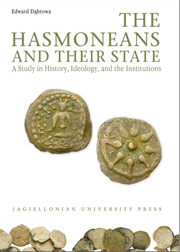Book contents
- Frontmatter
- Contents
- Introduction
- Abbreviations
- Part I Judea under the Hasmoneans (167–63 BCE)
- Part II The Institutions of the Hasmonean State
- I The Ruler
- II The State
- I Local Administration
- 2 Finances
- 3 Army
- Part III Society
- Conclusions
- Bibliography
- Index of Personal Names
- Index of Place Names
- Index of Ancient Sources
- Electrum - Volumes Published
- The Hasmonean State
I - Local Administration
from II - The State
Published online by Cambridge University Press: 05 September 2014
- Frontmatter
- Contents
- Introduction
- Abbreviations
- Part I Judea under the Hasmoneans (167–63 BCE)
- Part II The Institutions of the Hasmonean State
- I The Ruler
- II The State
- I Local Administration
- 2 Finances
- 3 Army
- Part III Society
- Conclusions
- Bibliography
- Index of Personal Names
- Index of Place Names
- Index of Ancient Sources
- Electrum - Volumes Published
- The Hasmonean State
Summary
During Hasmonean rule, their state's borders frequently changed. The first alteration was made already during the rule of Jonathan. Rather than through conquest, it was by administrative decision of king Demetrius I of Syria, who added to Judea three districts he removed from Samaria: Aphairema, Lydda, and Ramathain (cf. 1 Macc 10:30. 38; 11:34; Jos. AJ 13.50. 127) The first to enlarge Judea by force of arms was Simon. Although his gains were little, embracing Joppa with the area connecting it to the rest of Judea and Gezer (1 Macc 13:43–48; 14:5), their capture marked the beginning of gradual Judean expansion. The process gained momentum under John Hyrcanus, who conquered Idumea and Samaria, and small parts of Galilee with the city of Scythopolis (Beth-Shean). During the reign of Aristobulus I, Hasmonean rule was extended to more lands in Galilee and a part of southern Lebanon. Judea reached its greatest territorial expansion under Alexander Jannaeus. At the end of his reign, he controlled, in addition to lands mentioned above, a coastal strip from Gaza as far as Strato's Tower (except for Askelon), the Golan Heights, and large areas across Jordan in what had been biblical Gilead and Moab.
Efficient government of a steadily growing state required organization of territorial administration and appropriately staffing it. Neither element of the Hasmonean state is clearly confirmed in sources. It should be expected that the groundwork for this administration began to be laid with the first successes in fighting the Seleucids, and that its creator could be Jonathan.
- Type
- Chapter
- Information
- The Hasmoneans and their StateA Study in History, Ideology, and the Institutions, pp. 147 - 151Publisher: Jagiellonian University PressPrint publication year: 2009



